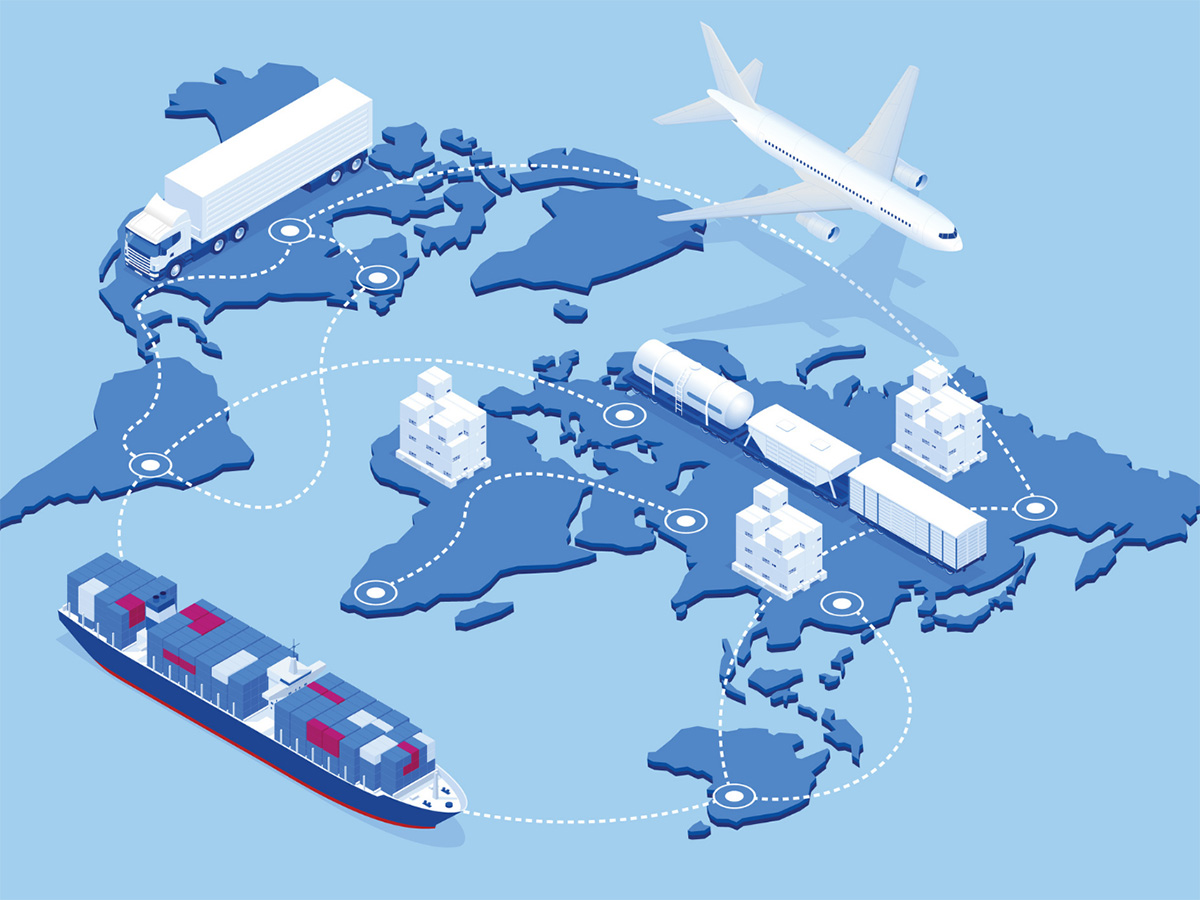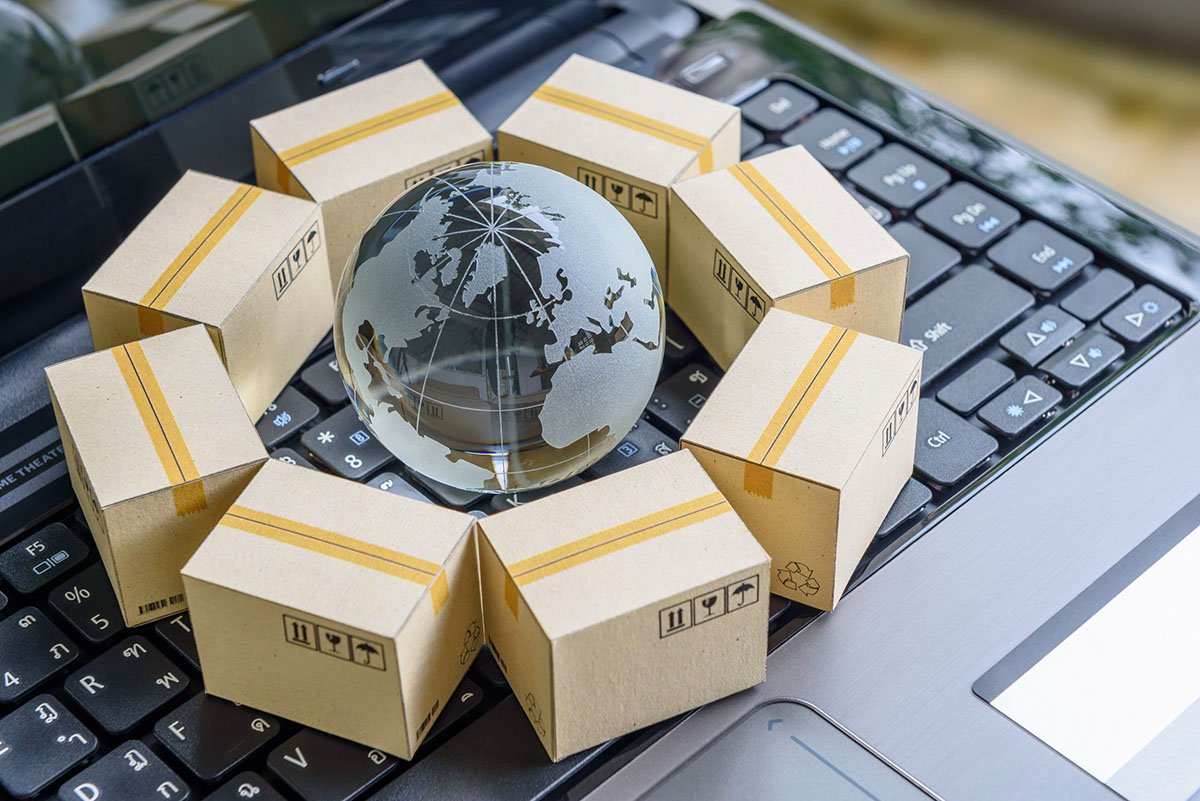

Finance
What Is Supply Chain Security?
Published: October 19, 2023
Discover the significance of supply chain security in the finance industry and how it safeguards your business from potential risks and threats.
(Many of the links in this article redirect to a specific reviewed product. Your purchase of these products through affiliate links helps to generate commission for LiveWell, at no extra cost. Learn more)
Table of Contents
- Introduction
- Definition of Supply Chain Security
- Importance of Supply Chain Security
- Risks and Vulnerabilities in Supply Chain
- Measures for Enhancing Supply Chain Security
- Technologies and Tools for Supply Chain Security
- Government Regulations and Standards for Supply Chain Security
- Challenges and Limitations of Supply Chain Security
- Case Studies on Supply Chain Security
- Future Trends in Supply Chain Security
- Conclusion
Introduction
Welcome to the world of supply chain security, where protecting the integrity and safety of products as they move through the global supply network takes center stage. In an increasingly interconnected and complex marketplace, supply chain security has become a critical concern for businesses and governments alike. The rapid growth of e-commerce, globalization, and outsourcing has amplified the need for robust security measures to safeguard supply chains against various risks and vulnerabilities.
Supply chain security refers to the policies, procedures, and practices implemented to ensure the safe transportation, storage, and handling of goods throughout the supply chain. It encompasses a range of activities, including risk assessment, threat detection, prevention, and response to security incidents. The ultimate goal is to safeguard the supply chain ecosystem from potential disruptions, including theft, counterfeiting, smuggling, tampering, and terrorism.
Effective supply chain security is crucial for several reasons. First and foremost, it protects consumers and businesses from the harmful consequences of compromised products. Defective, counterfeit, or contaminated goods can pose significant health and safety risks, damage brand reputation, and lead to legal liabilities. By implementing robust security measures, companies can build trust with their customers and ensure the quality and authenticity of their products.
Secondly, supply chain security plays a vital role in maintaining economic stability and supporting international trade. Disruptions in the supply chain, such as cargo theft or terrorism, can result in significant financial losses, trade disruptions, and negative impacts on the economy. By enhancing supply chain security, governments and businesses can foster a conducive environment for global trade and economic growth.
Furthermore, supply chain security is an essential component of national security. As supply chains become more interconnected and extend across international borders, they are vulnerable to infiltration by organized crime networks, illicit activities, and terrorist organizations. Ensuring the security and resilience of the supply chain is crucial for safeguarding a country’s critical infrastructure, protecting national interests, and preventing potential threats.
As supply chains become more global and complex, they face numerous risks and vulnerabilities. The next section will delve into the various challenges and potential threats that necessitate a comprehensive approach to supply chain security.
Definition of Supply Chain Security
Supply chain security encompasses the measures, practices, and strategies implemented to protect the integrity and security of goods as they move through the supply chain. It involves the identification and management of potential risks and vulnerabilities that can lead to loss, theft, tampering, counterfeiting, or other disruptions within the supply chain network.
This multidimensional concept seeks to ensure the safe and secure movement of products from the point of origin to the final destination, encompassing every stage of the supply chain, including sourcing, manufacturing, packaging, transportation, warehousing, and distribution. It involves collaboration and coordination among all stakeholders, including manufacturers, suppliers, distributors, logistics providers, retailers, and regulatory authorities, to mitigate risks and enhance security throughout the supply chain.
Supply chain security is not limited to physical security alone. It also includes the protection of information, data, and intellectual property related to the products being transported. This involves implementing robust cybersecurity measures to safeguard against data breaches, cyber-attacks, and unauthorized access to sensitive information. In an era when digital transformation and data-driven decision-making are becoming increasingly prevalent, the security of digital assets within the supply chain is paramount.
At its core, supply chain security focuses on implementing preventive measures and proactive strategies to mitigate risks before they result in security breaches or disruptions. This involves risk assessment, threat detection, developing comprehensive security plans, implementing security technologies and tools, training personnel, and establishing secure supply chain practices, policies, and procedures.
Supply chain security is an ongoing effort that requires continuous monitoring, evaluation, and improvement. As risks and threats evolve, so must the security measures in place. Proactive collaboration among supply chain stakeholders, sharing of information, and staying up-to-date with the latest security standards, regulations, and best practices is essential to ensuring robust supply chain security.
Next, we will explore the importance of supply chain security and its impact on businesses, consumers, and the global economy.
Importance of Supply Chain Security
Supply chain security plays a crucial role in ensuring the smooth and secure flow of goods through the global supply network. It is of utmost importance for several reasons:
Protecting Consumers and Businesses: Supply chain security helps safeguard consumers and businesses from the risks associated with compromised products. By implementing robust security measures, businesses can ensure the quality, authenticity, and safety of their products, thereby building and maintaining trust with their customers.
Maintaining Economic Stability: Disruptions in the supply chain, such as theft, counterfeiting, or tampering, can lead to financial losses and trade disruptions. Supply chain security helps minimize these risks and ensures the continuity of supply, thereby maintaining economic stability and supporting international trade.
Preserving Brand Reputation: The integrity of a brand can be severely damaged if its products are compromised within the supply chain. Supply chain security helps protect brand reputation by preventing counterfeit products from entering the market and ensuring that customers receive genuine, high-quality products.
Ensuring Regulatory Compliance: Various industries are subject to regulatory requirements and standards regarding supply chain security. Adhering to these regulations not only helps businesses avoid legal penalties but also demonstrates their commitment to maintaining the integrity and security of their supply chain.
Enhancing National Security: The security of the supply chain is integral to maintaining national security. An insecure supply chain can be infiltrated by organized crime networks, illicit activities, or even terrorist organizations. By implementing comprehensive supply chain security measures, governments can protect their critical infrastructure, national interests, and prevent potential threats.
Minimizing Financial Losses: Supply chain disruptions, such as theft, can result in significant financial losses for businesses. The implementation of effective supply chain security measures helps minimize these losses by reducing the chances of theft, damage, or loss of goods during transportation or storage.
Fostering Customer Trust: In today’s competitive business landscape, earning and maintaining customer trust is vital. Supply chain security demonstrates a commitment to product quality, safety, and authenticity, which can enhance customer confidence in the brand and lead to long-term customer loyalty.
By recognizing the importance of supply chain security and implementing robust measures, businesses can protect their customers, preserve brand reputation, ensure regulatory compliance, and contribute to the stability of the global economy.
In the next section, we will explore the various risks and vulnerabilities that can affect the security of the supply chain.
Risks and Vulnerabilities in Supply Chain
The global supply chain network is susceptible to various risks and vulnerabilities that can compromise the security and integrity of products. Understanding these risks is essential in developing effective supply chain security strategies. Here are some common risks and vulnerabilities in the supply chain:
Theft and Pilferage: Cargo theft is a significant risk in supply chain operations, particularly during transportation and warehousing. Criminals often target high-value goods, such as electronics, pharmaceuticals, and luxury items. The risk of theft increases in certain regions or during transit through high-crime areas, making it critical to implement security measures, including secure transportation, tracking technologies, and stringent access controls.
Counterfeiting: Counterfeit products can enter the supply chain at various points, compromising the integrity of brands and posing risks to consumer safety. Counterfeit goods not only lead to financial losses for businesses but can also damage brand reputation and result in legal liabilities. Vigilance, brand authentication technologies, and supply chain traceability measures are essential to identify and prevent the entry of counterfeit products into the market.
Tampering and Product Contamination: The deliberate tampering or contamination of products is a significant concern. These incidents can range from malicious product tampering, such as inserting foreign objects, to intentional contamination with harmful substances. Remote monitoring, strict quality control, tamper-evident packaging, and regular audits can help mitigate these risks and ensure product integrity.
Supply Chain Disruptions: Unforeseen events, such as natural disasters, political unrest, labor strikes, or public health emergencies, can disrupt the supply chain. These disruptions can lead to delays, shortages, and disruptions in the flow of goods. Implementing risk management strategies, such as diversifying suppliers, creating contingency plans, and maintaining strong communication with suppliers, can help mitigate these risks and ensure business continuity.
Cybersecurity Threats: As supply chains rely on digital systems and technologies, they become vulnerable to cyber-attacks. Data breaches, ransomware attacks, and other cybersecurity threats can disrupt operations, compromise sensitive information, and lead to financial losses. Robust cybersecurity measures, including firewalls, encryption, secure data storage, and employee training, are essential to protect against these threats.
Regulatory Compliance: Failure to comply with regulatory requirements and industry standards can expose businesses to legal penalties and reputational damage. Supply chains must navigate complex regulations governing customs, trade, safety, and security. Staying up-to-date with regulations, conducting regular audits, and implementing compliance programs are vital for mitigating legal risks and ensuring smooth operations.
Supplier Reliability: Dependence on suppliers for the timely and accurate delivery of goods can pose risks to the supply chain. Supplier disruptions, such as bankruptcy, quality issues, or logistical challenges, can impact the overall supply chain operations. Conducting due diligence in supplier selection, maintaining strong supplier relationships, and implementing backup plans can help mitigate these risks.
These are just a few examples of the risks and vulnerabilities that supply chains face. Addressing these challenges requires a comprehensive and proactive approach to supply chain security, which we will explore in the next section.
Measures for Enhancing Supply Chain Security
To tackle the risks and vulnerabilities in the supply chain, various measures can be implemented to enhance supply chain security. These measures help safeguard products, mitigate threats, and ensure the smooth flow of goods. Here are some effective strategies for enhancing supply chain security:
Risk Assessment: Conducting a comprehensive risk assessment is the first step in identifying potential vulnerabilities within the supply chain. This involves evaluating each stage of the supply chain, from sourcing to delivery, to identify weak points and potential security breaches. By understanding the risks, businesses can develop targeted security strategies to mitigate these vulnerabilities.
Supply Chain Visibility: Enhancing visibility across the supply chain is crucial for identifying potential threats and responding to them effectively. Implementing technologies such as real-time tracking systems, RFID (Radio Frequency Identification) tags, and GPS (Global Positioning System) can provide real-time visibility into the movement of goods. This enables quick identification of any deviations from the planned route and allows for immediate action to be taken.
Collaboration and Information Sharing: Collaboration among all stakeholders in the supply chain is essential for effective security management. Sharing information related to risks, threats, and best practices allows for a collective effort to identify and address security concerns proactively. Industry collaborations, public-private partnerships, and information-sharing platforms help establish a unified approach to supply chain security.
Secure Packaging and Sealing: Utilizing secure packaging techniques, such as tamper-evident seals and barrier protection, helps prevent unauthorized access and tampering. This ensures the integrity of products throughout the supply chain. Additionally, implementing serialization and labeling technologies can enable traceability, making it easier to identify authentic products and detect counterfeit goods.
Personnel Training and Background Checks: Ensuring that all personnel involved in the supply chain undergo proper training on security protocols, including recognizing potential threats and responding to security incidents, is crucial. Conducting thorough background checks on employees and partners can help identify individuals with a criminal history or potential security risks.
Secure Transportation: Transporting goods securely is paramount for ensuring supply chain security. Employing various security measures such as GPS tracking, secure locks, route planning, and driver training can help mitigate the risk of theft or tampering during transportation. Utilizing verified and reputable transportation providers also adds an extra layer of security.
Cybersecurity Measures: Protecting digital assets within the supply chain is essential in the digital era. Implementing robust cybersecurity measures, such as firewalls, encryption, and secure network infrastructure, helps safeguard against cyber-attacks, data breaches, and unauthorized access to sensitive information. Regular system audits and employee training on cybersecurity best practices are also critical.
Supplier Management: Properly managing supplier relationships is crucial for supply chain security. Conducting due diligence in supplier selection, assessing their security protocols and capabilities, and establishing contracts that include security requirements can help ensure that suppliers adhere to the desired security standards. Regular supplier performance evaluations and audits contribute to maintaining supply chain security.
Continuous Monitoring and Evaluation: Supply chain security cannot be a one-time effort. Continuous monitoring, evaluation, and improvement are essential to adapt to evolving threats and vulnerabilities. Regular security audits, incident response planning and testing, and staying up-to-date with the latest security technologies and practices contribute to maintaining robust supply chain security.
By implementing these measures, businesses can significantly enhance supply chain security, protect against various risks, and ensure the safe and secure movement of goods throughout the supply chain network.
In the next section, we will explore the technologies and tools that aid in supply chain security.
Technologies and Tools for Supply Chain Security
In an increasingly complex and globalized supply chain landscape, the use of advanced technologies and tools is critical to enhance supply chain security. These technologies and tools provide increased visibility, traceability, and real-time insights, allowing businesses to identify and address security threats effectively. Here are some key technologies and tools used in supply chain security:
1. IoT (Internet of Things): IoT devices, such as sensors, RFID tags, and smart devices, enable real-time tracking and monitoring of goods throughout the supply chain. These devices provide valuable data on location, temperature, humidity, and other environmental conditions, helping detect any anomalies or potential security breaches. By leveraging IoT, businesses can improve visibility and responsiveness to security incidents.
2. Blockchain: Blockchain technology offers secure, transparent, and decentralized record-keeping capabilities. It enables the creation of an immutable and tamper-resistant digital ledger, ensuring the authenticity and integrity of transactions and product information. Blockchain can be used to track and verify the origin, movement, and ownership of goods, reducing the risk of counterfeit products and enhancing supply chain security.
3. GPS Tracking: Global Positioning System (GPS) technology is widely used to track the location and movement of goods during transportation. It allows businesses to monitor the route, speed, and status of shipments in real-time. GPS tracking enhances supply chain visibility, enables timely intervention in case of security incidents or deviations from planned routes, and assists in recovery efforts in the event of theft or loss.
4. Video Surveillance: Video surveillance systems, comprising cameras, motion sensors, and video analytics, provide continuous monitoring of warehouses, storage facilities, and transportation hubs. These systems can help detect security breaches, identify suspicious activities, and provide evidence in investigations. Video surveillance acts as a deterrent for theft and tampering incidents, enhancing the overall security of the supply chain.
5. Data Analytics: The use of data analytics tools enables businesses to analyze large amounts of data collected from various sources within the supply chain. By applying advanced analytics techniques, patterns, anomalies, and potential security threats can be identified. Data analytics aids in risk assessment, predictive analysis, and decision-making, contributing to proactive supply chain security measures.
6. Biometric Authentication: Biometric technologies, such as fingerprint or facial recognition systems, provide secure access control in warehouses, manufacturing facilities, and distribution centers. Biometric authentication ensures that only authorized personnel can access critical areas, reducing the risk of insider threats and unauthorized access to sensitive information or products.
7. Supply Chain Risk Management Software: Supply chain risk management software helps businesses assess, monitor, and mitigate risks across the supply chain. These software solutions provide visibility into potential risks, prioritize them based on severity, and assist in developing risk mitigation strategies. They enable businesses to streamline security-related operations, automate risk assessments, and improve overall supply chain security performance.
8. Artificial Intelligence (AI) and Machine Learning: AI and machine learning technologies can analyze vast amounts of data to identify patterns and anomalies that may indicate security threats. These technologies can detect abnormalities in supply chain operations, flag potential security breaches, and provide real-time alerts. AI-powered predictive analytics can also help forecast risks, enabling proactive security measures to be implemented.
Adopting these technologies and tools can significantly enhance supply chain security by improving visibility, enabling proactive risk management, and enabling rapid response to security incidents. However, it is important to assess the specific needs and challenges of the supply chain and implement technologies that align with the organizational goals and objectives.
In the next section, we will explore the government regulations and standards related to supply chain security.
Government Regulations and Standards for Supply Chain Security
Recognizing the importance of maintaining a secure and resilient supply chain, governments around the world have implemented various regulations and standards to ensure supply chain security. These regulations aim to protect consumers, prevent illicit activities, and promote the smooth flow of goods. Here are some notable government regulations and standards related to supply chain security:
Customs-Trade Partnership Against Terrorism (C-TPAT): C-TPAT is a U.S.-led voluntary program that focuses on enhancing supply chain security while facilitating the flow of goods. It encourages businesses to implement robust security measures, risk assessments, and supply chain best practices. By participating in C-TPAT, companies gain benefits such as reduced customs inspections and expedited processing of shipments.
European Union Authorized Economic Operator (AEO): The AEO certification program, established by the European Union (EU), aims to enhance supply chain security and facilitate legitimate trade. It provides mutual recognition of security standards among EU member states and offers benefits such as simplified customs procedures, reduced security-related controls, and increased business credibility.
Transportation Security Administration (TSA): The TSA, a U.S. government agency, implements security regulations for the transportation of goods, focusing on the aviation industry. It sets requirements for cargo screening, security training for personnel, and the use of security technologies to mitigate risks within the supply chain.
International Organization for Standardization (ISO): ISO has developed several standards related to supply chain security. Notably, ISO 28000:2007 specifies requirements for a security management system within the supply chain. This standard covers areas such as risk assessment, physical security, personnel security, and information management to ensure the security of goods during transportation and storage.
World Customs Organization (WCO) Framework of Standards: The WCO Framework of Standards provides guidelines and best practices for countries to enhance supply chain security. It focuses on areas such as risk management, secure trade processes, and information sharing among customs administrations to combat illicit trade and protect legitimate supply chains.
International Air Transport Association (IATA) Secure Freight: IATA’s Secure Freight program aims to improve air cargo security by implementing globally recognized security standards and best practices. It focuses on various aspects, including physical security, personnel screening, and data management, to ensure the safety and security of air cargo shipments.
Food Safety Modernization Act (FSMA): In the United States, the FSMA focuses on improving the safety and security of the food supply chain. It sets regulations for preventive controls, hazard analysis, and risk-based supply chain programs to ensure the integrity and safety of food products from farm to fork.
In addition to these regulations and standards, many countries have their own specific requirements and initiatives to address supply chain security. These regulations aim to reduce the risk of theft, tampering, counterfeiting, and terrorism within the supply chain, ensuring the safety and security of goods as they move through the global trade network.
Businesses operating in the supply chain must stay informed about these regulations and standards applicable to their respective regions and industries. Compliance with these requirements not only protects the integrity and security of the supply chain but also helps businesses maintain a competitive edge and gain the trust of customers and partners.
In the next section, we will explore the challenges and limitations associated with supply chain security.
Challenges and Limitations of Supply Chain Security
While supply chain security is crucial for ensuring the safe and secure movement of goods, there are several challenges and limitations that businesses face in implementing effective security measures. Understanding these challenges is essential in developing strategies to overcome them. Here are some common challenges and limitations of supply chain security:
Global and Complex Nature of Supply Chains: Modern supply chains are intricate and interconnected, involving numerous stakeholders, multiple countries, and various transportation modes. This complexity makes it challenging to implement consistent security measures throughout the entire supply chain network.
Information Sharing and Collaboration: Effective supply chain security requires collaboration and information sharing among all stakeholders. However, sharing sensitive information about products, operations, and security measures can raise concerns about confidentiality, competitiveness, and trust among supply chain partners. Overcoming these barriers and establishing effective collaboration can be a significant challenge.
Cost and Resource Constraints: Implementing robust supply chain security measures requires significant investment in technology, personnel training, and infrastructure upgrades. However, budget constraints and resource limitations can hinder the ability of businesses, especially small and medium-sized enterprises (SMEs), to invest in comprehensive security solutions.
Constantly Evolving Threat Landscape: The threat landscape is continually evolving, with new risks and vulnerabilities emerging regularly. Criminals are constantly finding innovative ways to exploit supply chain weaknesses. Keeping up with these evolving threats and adapting security measures accordingly requires continuous monitoring and proactive response strategies.
Third-Party Risks: Supply chains often rely on various third-party partners, such as suppliers, logistics providers, and contractors. The security practices and vulnerabilities of these third parties can impact the overall security of the supply chain. Ensuring that all parties adhere to robust security protocols and standards can be a considerable challenge.
Regulatory Complexity: Compliance with government regulations and industry standards related to supply chain security can be complex and time-consuming. Staying up-to-date with changing regulations, maintaining documentation, and aligning with multiple regulatory frameworks across different regions can pose significant challenges, particularly for businesses with international operations.
Insider Threats: Despite implementing external security measures, the risk of insider threats within the supply chain cannot be ignored. Disgruntled employees, contractors, or partners with access to sensitive information and goods can compromise supply chain security. Detecting and mitigating insider threats require robust background checks, training programs, and strict access controls.
Technological Advancements: While technology plays a crucial role in supply chain security, it also presents its own set of challenges. Rapid advancements in technology can make existing security measures obsolete, requiring businesses to constantly upgrade their systems. Moreover, the increasing complexity of technology can introduce new vulnerabilities and the potential for cyber-attacks.
Addressing these challenges and limitations requires a holistic approach to supply chain security that combines technology, collaboration, risk management, and ongoing vigilance. Implementing proactive strategies, building strong relationships with supply chain partners, and staying informed about evolving threats are essential in maintaining robust supply chain security.
In the next section, we will examine case studies that highlight successful implementations of supply chain security measures.
Case Studies on Supply Chain Security
Examining real-world case studies can shed light on successful implementations of supply chain security measures and provide insights into the benefits that businesses have achieved. Here are a few notable case studies:
1. Maersk and IBM Blockchain Initiative: In 2018, Maersk, a global shipping company, collaborated with IBM to develop a blockchain-based platform for supply chain security. The initiative aimed to improve transparency, efficiency, and security in global trade. By using blockchain technology to digitize documentation and track container movements, they reduced paperwork, improved cargo visibility, and secured against unauthorized access or tampering.
2. Volkswagen RFID Tracking System: Volkswagen implemented an RFID (Radio Frequency Identification) tracking system for its supply chain to enhance security and traceability. Each vehicle component received an RFID tag, allowing real-time tracking and monitoring throughout the manufacturing process. This technology enabled Volkswagen to verify the authenticity of components, detect irregularities, and reduce the risk of counterfeiting and unauthorized substitutions.
3. Nestlé’s Serialization Program: Nestlé, a multinational food and beverage company, embarked on a serialization program to enhance supply chain security for its products. The program involved assigning unique serial numbers to each product unit, enabling end-to-end traceability. By implementing this system, Nestlé was able to detect and prevent the entry of counterfeit products into the market, ensuring consumer safety and protecting brand reputation.
4. Walmart’s Blockchain-based Food Traceability: Walmart, one of the largest retailers globally, embraced blockchain technology to enhance food traceability and supply chain security. Through a blockchain-powered system, Walmart tracks and records information about the origin, processing, and shipping of food products, improving transparency and reducing response time in the event of food safety issues or recalls.
5. DHL Global Forwarding Cargo Insurance: DHL, a leading logistics company, offers cargo insurance services that provide an added layer of security for shipments. Through this service, DHL covers the cost of lost or damaged goods during transportation, mitigating financial risks for businesses. This insurance solution enhances supply chain security by providing protection against unforeseen events and ensuring business continuity.
These case studies highlight the effective implementation of supply chain security measures by leading organizations. By leveraging technology, collaboration, and innovative approaches, these companies have achieved significant improvements in supply chain transparency, traceability, and risk management.
However, it is important to note that the success of these case studies is context-specific, and each business must assess their unique needs and risks to develop appropriate supply chain security solutions.
In the next section, we will explore the future trends and potential advancements in the field of supply chain security.
Future Trends in Supply Chain Security
The field of supply chain security is continuously evolving to address emerging risks, advancements in technology, and changing business landscapes. Several trends are expected to shape the future of supply chain security. Here are some key trends to watch:
1. Internet of Things (IoT) Integration: The integration of IoT devices within the supply chain is expected to become more prevalent. IoT sensors and devices provide real-time data on product location, condition, and security, enabling proactive monitoring and response to potential threats. As IoT technology advances, more devices will be interconnected, enhancing supply chain visibility and security.
2. Artificial Intelligence (AI) and Machine Learning: AI and machine learning algorithms are poised to play a significant role in supply chain security. These technologies can analyze vast amounts of data, identify patterns, detect anomalies, and predict security risks. AI-powered predictive analytics can help businesses anticipate and prevent security incidents, allowing for proactive risk management.
3. Blockchain for Supply Chain Security: Blockchain technology is expected to become more widely adopted for enhancing supply chain security. Blockchain’s decentralized and tamper-resistant nature provides secure and transparent record-keeping, enabling improved traceability, authenticity verification, and secure transactions across the supply chain. This technology has the potential to revolutionize supply chain security by reducing fraud and counterfeit products.
4. Advanced Authentication and Biometrics: As security threats evolve, traditional authentication methods may no longer be sufficient. Advanced authentication techniques, such as biometrics (fingerprint, facial recognition), voice recognition, and multi-factor authentication, are likely to be adopted for securing access to critical supply chain areas, systems, and data.
5. Enhanced Cybersecurity Measures: With the increasing reliance on digital systems and data, cybersecurity will continue to be a critical aspect of supply chain security. Advancements in cybersecurity technologies, such as threat intelligence, encryption, and behavioral analytics, will be crucial in protecting against cyber threats, data breaches, and unauthorized access to sensitive information.
6. Supply Chain Resilience: As supply chains become more globalized and interconnected, the ability to quickly recover from disruptions will be paramount. Building resilient supply chains that can adapt to unexpected events, such as natural disasters or geopolitical shifts, will be essential. This includes implementing strategies for redundancy, diversification, and backup plans to ensure continuity of operations.
7. Enhanced Supply Chain Collaboration: Collaboration among supply chain stakeholders will continue to be vital for effective supply chain security. Through increased information sharing, collaborative risk assessment, and joint security initiatives, businesses can identify and address vulnerabilities more effectively. Public-private partnerships and industry partnerships will play a significant role in driving supply chain security collaboration.
8. Ethical Supply Chain Security: An emerging trend is the focus on ethical supply chain security, which involves ensuring that security measures align with social and environmental responsibilities. This includes considerations such as the reduction of carbon footprint, sustainable sourcing practices, and adherence to fair trade principles. Ethical supply chain security will become an integral part of corporate social responsibility initiatives.
These trends are expected to shape the future of supply chain security, driving innovation and advancements in technology and practices. Businesses that proactively embrace these trends and adopt appropriate security measures will be better equipped to protect their supply chains from emerging risks and maintain the integrity and safety of their products.
In the final section, we will conclude with a summary of the key points discussed in this article.
Conclusion
Supply chain security is a critical aspect of modern business operations, ensuring the safe and secure movement of goods throughout the global supply chain network. From protecting consumers and preserving brand reputation to maintaining economic stability and national security, the importance of supply chain security cannot be overstated.
In this article, we explored the definition of supply chain security, highlighting its multidimensional nature and its role in safeguarding products from risks and vulnerabilities. We discussed the importance of implementing comprehensive security measures, such as risk assessments, collaboration, and technologies like IoT, blockchain, and AI, to enhance supply chain security.
We also delved into the challenges and limitations faced in implementing effective supply chain security measures, recognizing the complexities of global supply chains, cost constraints, regulatory compliance, and evolving threat landscapes. However, with proactive strategies, collaboration, and ongoing vigilance, these challenges can be overcome.
Government regulations and standards, such as C-TPAT, AEO, and ISO, have been established to promote supply chain security. Compliance with these regulations is essential to ensure the integrity and safety of supply chains and enhance trust among stakeholders.
Looking ahead, we explored future trends, including IoT integration, AI, blockchain adoption, and advanced authentication, which will shape the landscape of supply chain security. These trends pave the way for improved visibility, traceability, and proactive risk management.
In conclusion, supply chain security is a dynamic and evolving field that requires a proactive mindset, collaboration, and the adoption of innovative technologies and practices. By implementing robust security measures, businesses can protect their customers, preserve brand reputation, maintain economic stability, and contribute to the overall security of the global supply chain network.
As the world becomes more interconnected and threats continue to evolve, it is crucial for businesses to prioritize supply chain security as a fundamental aspect of their operations. By doing so, they can ensure the integrity, safety, and resilience of their supply chains, ultimately driving sustainable growth and success in a global marketplace.














